A Comprehensive Analysis of the Morrisons Business Environment Report
VerifiedAdded on 2020/11/23
|15
|4622
|61
Report
AI Summary
This report provides a comprehensive analysis of Morrisons' business environment. It begins with an introduction to the business environment and defines the size, scope, and legal structure of Morrisons as a private organization. The report also contrasts it with public and voluntary organizations, using examples like NHS and British Heart Foundation. It examines the growth of the international business environment and its impact on Morrisons. The report further details the company's size, scope, vision, mission, and objectives, followed by stakeholder analysis. Task 2 explores the relationship between various business functions (HR, finance, marketing, and production) and their link to the company's objectives and organizational structure. The report then delves into the positive and negative impacts of the macro environment using SWOT and PESTLE analysis. Finally, the report concludes by summarizing the key findings and providing references.
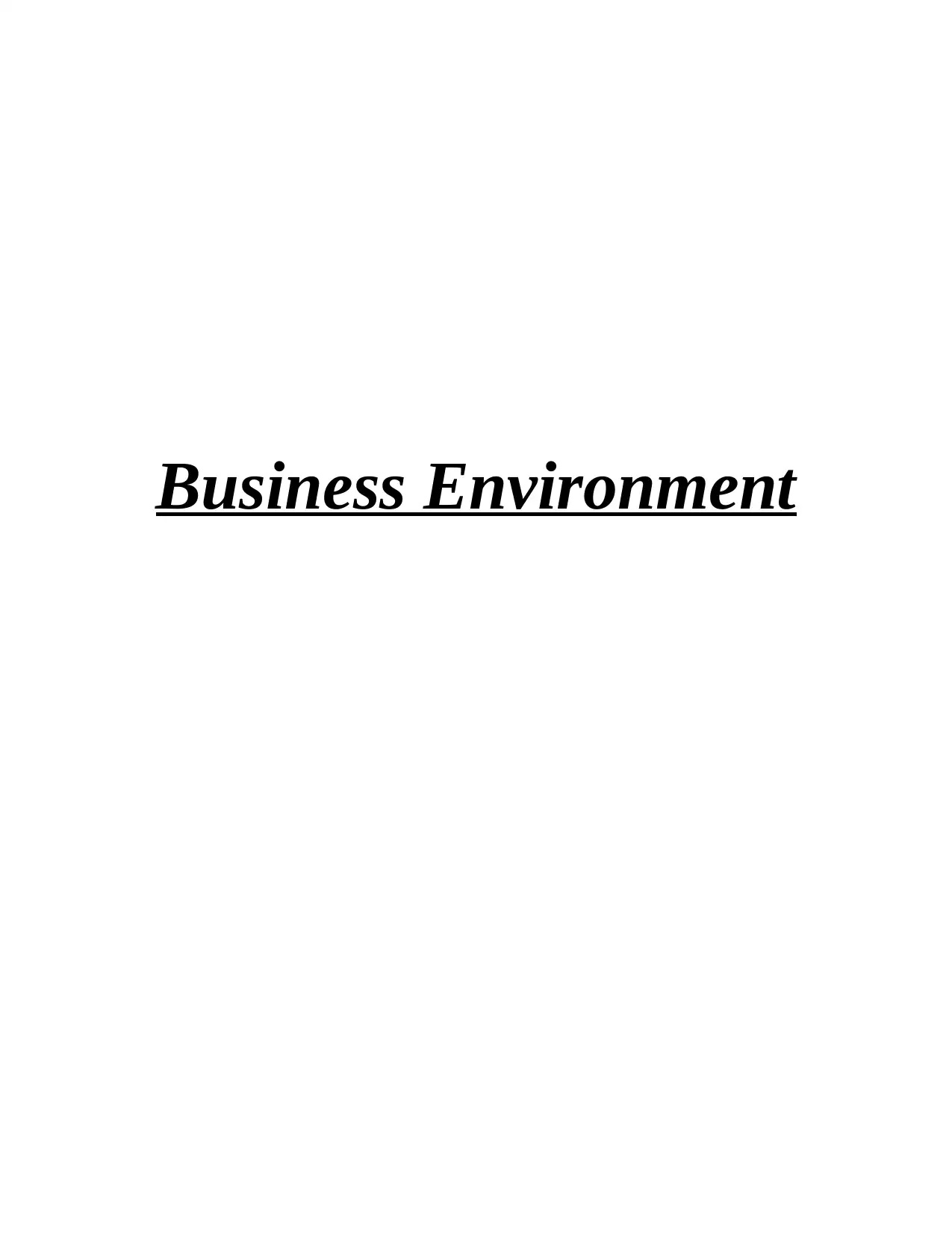
Business Environment
Paraphrase This Document
Need a fresh take? Get an instant paraphrase of this document with our AI Paraphraser
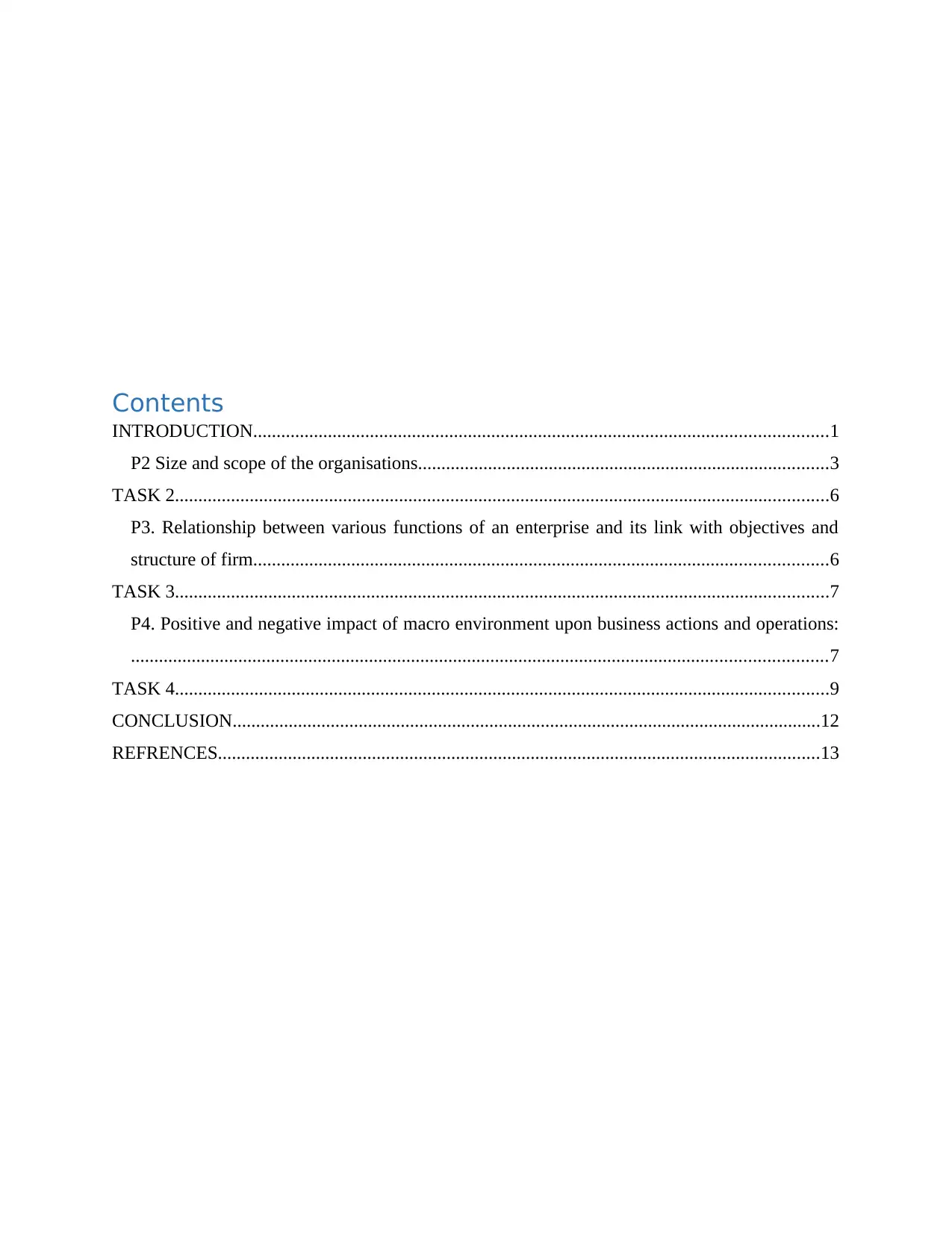
Contents
INTRODUCTION...........................................................................................................................1
P2 Size and scope of the organisations........................................................................................3
TASK 2............................................................................................................................................6
P3. Relationship between various functions of an enterprise and its link with objectives and
structure of firm...........................................................................................................................6
TASK 3............................................................................................................................................7
P4. Positive and negative impact of macro environment upon business actions and operations:
.....................................................................................................................................................7
TASK 4............................................................................................................................................9
CONCLUSION..............................................................................................................................12
REFRENCES.................................................................................................................................13
INTRODUCTION...........................................................................................................................1
P2 Size and scope of the organisations........................................................................................3
TASK 2............................................................................................................................................6
P3. Relationship between various functions of an enterprise and its link with objectives and
structure of firm...........................................................................................................................6
TASK 3............................................................................................................................................7
P4. Positive and negative impact of macro environment upon business actions and operations:
.....................................................................................................................................................7
TASK 4............................................................................................................................................9
CONCLUSION..............................................................................................................................12
REFRENCES.................................................................................................................................13
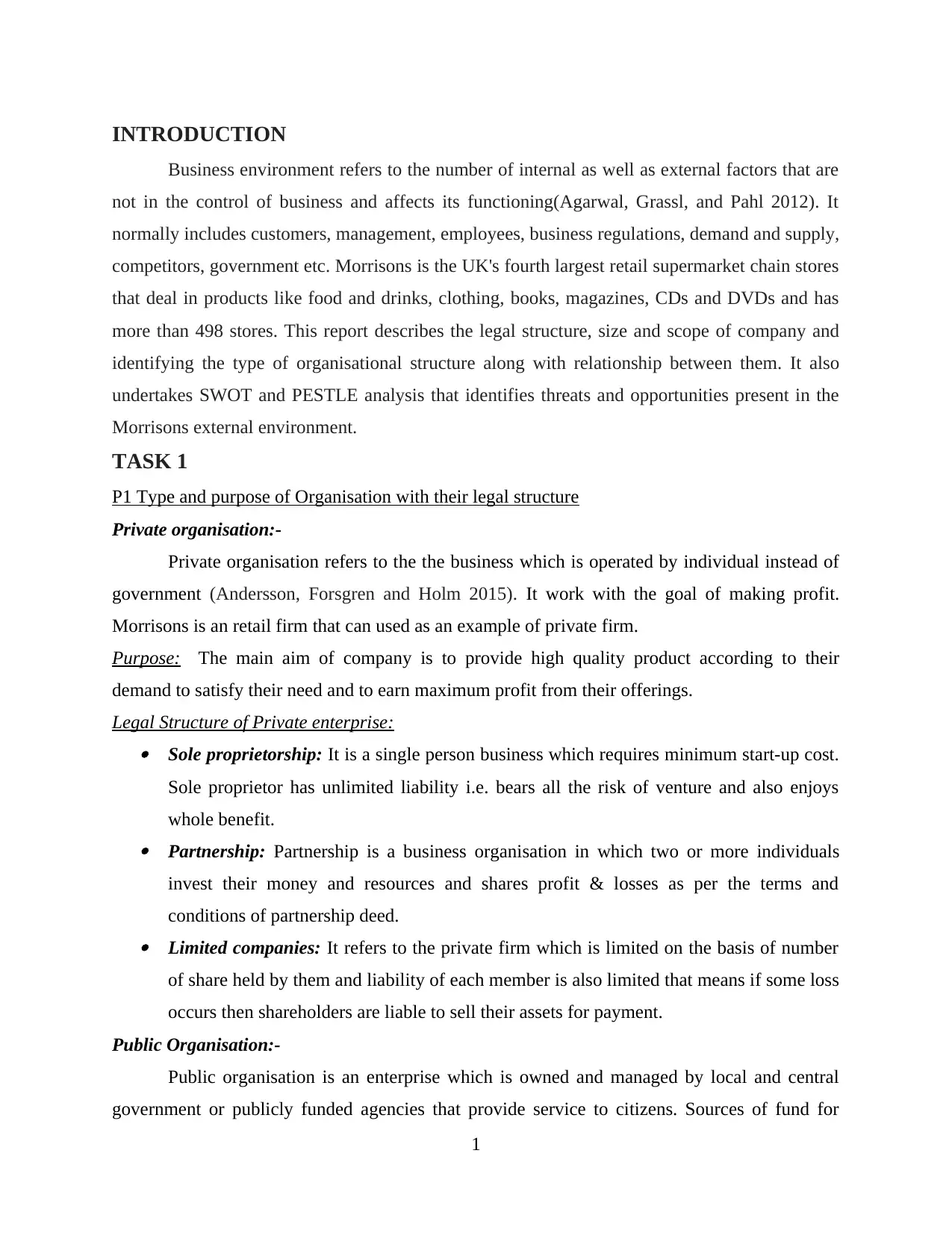
INTRODUCTION
Business environment refers to the number of internal as well as external factors that are
not in the control of business and affects its functioning(Agarwal, Grassl, and Pahl 2012). It
normally includes customers, management, employees, business regulations, demand and supply,
competitors, government etc. Morrisons is the UK's fourth largest retail supermarket chain stores
that deal in products like food and drinks, clothing, books, magazines, CDs and DVDs and has
more than 498 stores. This report describes the legal structure, size and scope of company and
identifying the type of organisational structure along with relationship between them. It also
undertakes SWOT and PESTLE analysis that identifies threats and opportunities present in the
Morrisons external environment.
TASK 1
P1 Type and purpose of Organisation with their legal structure
Private organisation:-
Private organisation refers to the the business which is operated by individual instead of
government (Andersson, Forsgren and Holm 2015). It work with the goal of making profit.
Morrisons is an retail firm that can used as an example of private firm.
Purpose: The main aim of company is to provide high quality product according to their
demand to satisfy their need and to earn maximum profit from their offerings.
Legal Structure of Private enterprise: Sole proprietorship: It is a single person business which requires minimum start-up cost.
Sole proprietor has unlimited liability i.e. bears all the risk of venture and also enjoys
whole benefit. Partnership: Partnership is a business organisation in which two or more individuals
invest their money and resources and shares profit & losses as per the terms and
conditions of partnership deed. Limited companies: It refers to the private firm which is limited on the basis of number
of share held by them and liability of each member is also limited that means if some loss
occurs then shareholders are liable to sell their assets for payment.
Public Organisation:-
Public organisation is an enterprise which is owned and managed by local and central
government or publicly funded agencies that provide service to citizens. Sources of fund for
1
Business environment refers to the number of internal as well as external factors that are
not in the control of business and affects its functioning(Agarwal, Grassl, and Pahl 2012). It
normally includes customers, management, employees, business regulations, demand and supply,
competitors, government etc. Morrisons is the UK's fourth largest retail supermarket chain stores
that deal in products like food and drinks, clothing, books, magazines, CDs and DVDs and has
more than 498 stores. This report describes the legal structure, size and scope of company and
identifying the type of organisational structure along with relationship between them. It also
undertakes SWOT and PESTLE analysis that identifies threats and opportunities present in the
Morrisons external environment.
TASK 1
P1 Type and purpose of Organisation with their legal structure
Private organisation:-
Private organisation refers to the the business which is operated by individual instead of
government (Andersson, Forsgren and Holm 2015). It work with the goal of making profit.
Morrisons is an retail firm that can used as an example of private firm.
Purpose: The main aim of company is to provide high quality product according to their
demand to satisfy their need and to earn maximum profit from their offerings.
Legal Structure of Private enterprise: Sole proprietorship: It is a single person business which requires minimum start-up cost.
Sole proprietor has unlimited liability i.e. bears all the risk of venture and also enjoys
whole benefit. Partnership: Partnership is a business organisation in which two or more individuals
invest their money and resources and shares profit & losses as per the terms and
conditions of partnership deed. Limited companies: It refers to the private firm which is limited on the basis of number
of share held by them and liability of each member is also limited that means if some loss
occurs then shareholders are liable to sell their assets for payment.
Public Organisation:-
Public organisation is an enterprise which is owned and managed by local and central
government or publicly funded agencies that provide service to citizens. Sources of fund for
1
⊘ This is a preview!⊘
Do you want full access?
Subscribe today to unlock all pages.

Trusted by 1+ million students worldwide
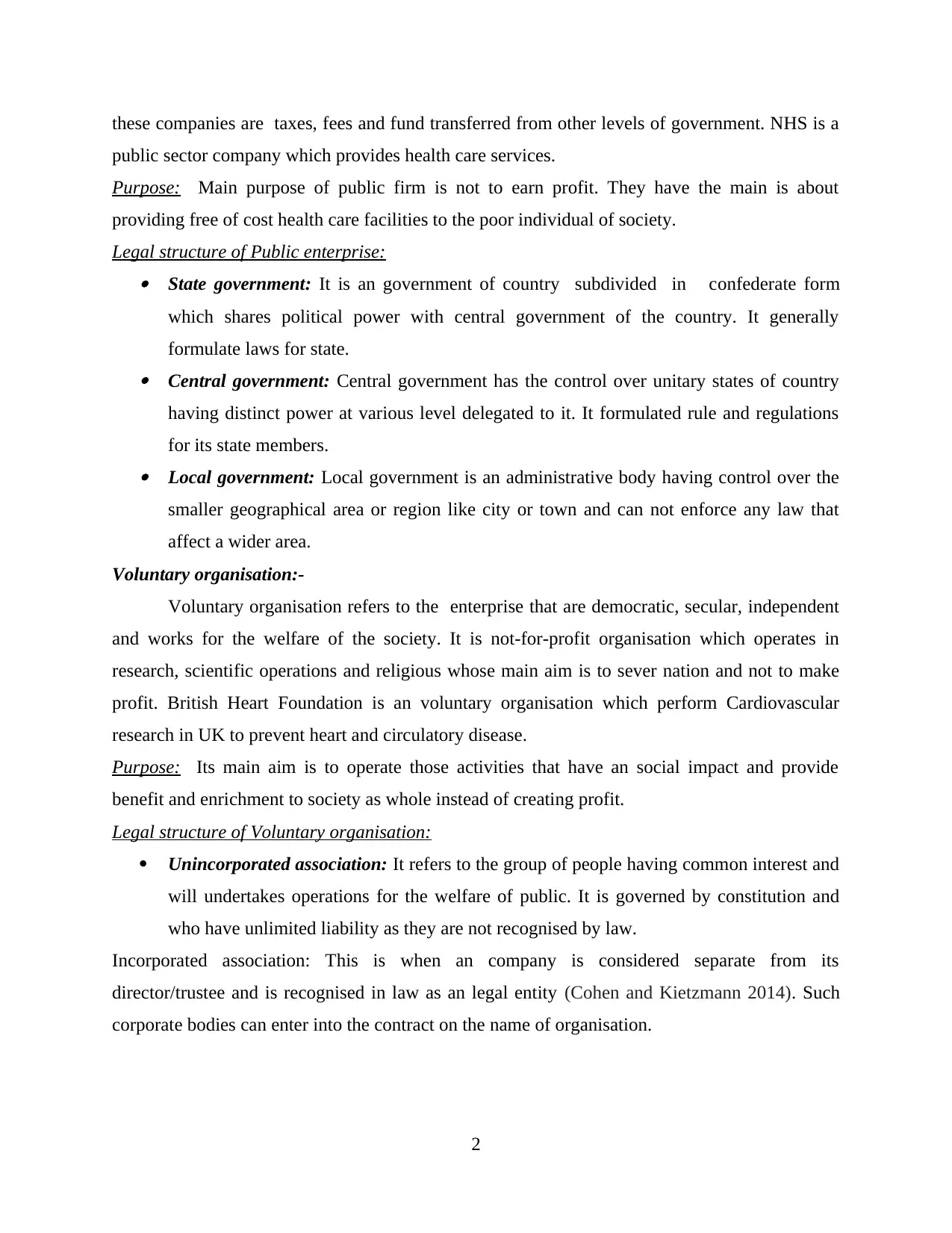
these companies are taxes, fees and fund transferred from other levels of government. NHS is a
public sector company which provides health care services.
Purpose: Main purpose of public firm is not to earn profit. They have the main is about
providing free of cost health care facilities to the poor individual of society.
Legal structure of Public enterprise: State government: It is an government of country subdivided in confederate form
which shares political power with central government of the country. It generally
formulate laws for state. Central government: Central government has the control over unitary states of country
having distinct power at various level delegated to it. It formulated rule and regulations
for its state members. Local government: Local government is an administrative body having control over the
smaller geographical area or region like city or town and can not enforce any law that
affect a wider area.
Voluntary organisation:-
Voluntary organisation refers to the enterprise that are democratic, secular, independent
and works for the welfare of the society. It is not-for-profit organisation which operates in
research, scientific operations and religious whose main aim is to sever nation and not to make
profit. British Heart Foundation is an voluntary organisation which perform Cardiovascular
research in UK to prevent heart and circulatory disease.
Purpose: Its main aim is to operate those activities that have an social impact and provide
benefit and enrichment to society as whole instead of creating profit.
Legal structure of Voluntary organisation:
Unincorporated association: It refers to the group of people having common interest and
will undertakes operations for the welfare of public. It is governed by constitution and
who have unlimited liability as they are not recognised by law.
Incorporated association: This is when an company is considered separate from its
director/trustee and is recognised in law as an legal entity (Cohen and Kietzmann 2014). Such
corporate bodies can enter into the contract on the name of organisation.
2
public sector company which provides health care services.
Purpose: Main purpose of public firm is not to earn profit. They have the main is about
providing free of cost health care facilities to the poor individual of society.
Legal structure of Public enterprise: State government: It is an government of country subdivided in confederate form
which shares political power with central government of the country. It generally
formulate laws for state. Central government: Central government has the control over unitary states of country
having distinct power at various level delegated to it. It formulated rule and regulations
for its state members. Local government: Local government is an administrative body having control over the
smaller geographical area or region like city or town and can not enforce any law that
affect a wider area.
Voluntary organisation:-
Voluntary organisation refers to the enterprise that are democratic, secular, independent
and works for the welfare of the society. It is not-for-profit organisation which operates in
research, scientific operations and religious whose main aim is to sever nation and not to make
profit. British Heart Foundation is an voluntary organisation which perform Cardiovascular
research in UK to prevent heart and circulatory disease.
Purpose: Its main aim is to operate those activities that have an social impact and provide
benefit and enrichment to society as whole instead of creating profit.
Legal structure of Voluntary organisation:
Unincorporated association: It refers to the group of people having common interest and
will undertakes operations for the welfare of public. It is governed by constitution and
who have unlimited liability as they are not recognised by law.
Incorporated association: This is when an company is considered separate from its
director/trustee and is recognised in law as an legal entity (Cohen and Kietzmann 2014). Such
corporate bodies can enter into the contract on the name of organisation.
2
Paraphrase This Document
Need a fresh take? Get an instant paraphrase of this document with our AI Paraphraser
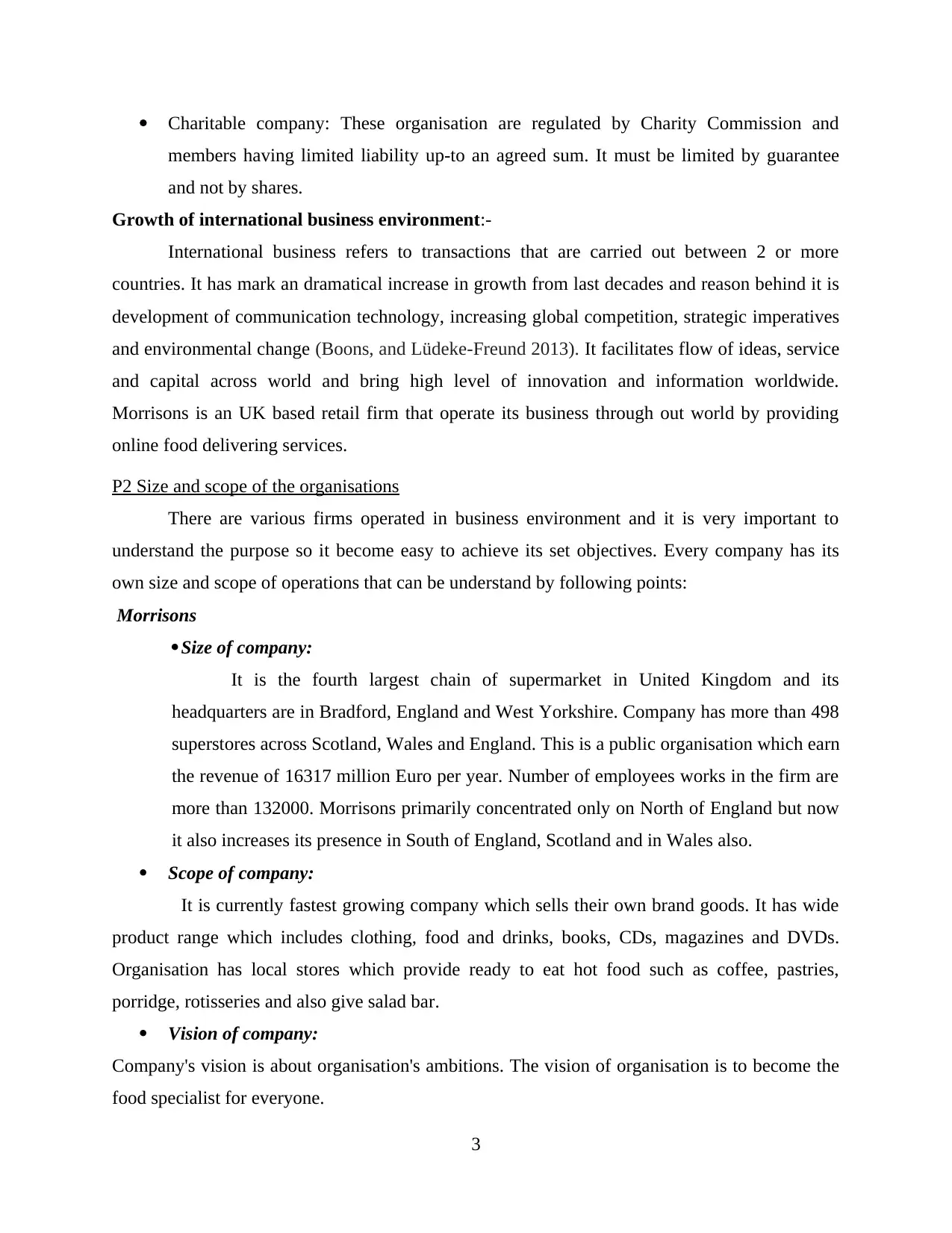
Charitable company: These organisation are regulated by Charity Commission and
members having limited liability up-to an agreed sum. It must be limited by guarantee
and not by shares.
Growth of international business environment:-
International business refers to transactions that are carried out between 2 or more
countries. It has mark an dramatical increase in growth from last decades and reason behind it is
development of communication technology, increasing global competition, strategic imperatives
and environmental change (Boons, and Lüdeke-Freund 2013). It facilitates flow of ideas, service
and capital across world and bring high level of innovation and information worldwide.
Morrisons is an UK based retail firm that operate its business through out world by providing
online food delivering services.
P2 Size and scope of the organisations
There are various firms operated in business environment and it is very important to
understand the purpose so it become easy to achieve its set objectives. Every company has its
own size and scope of operations that can be understand by following points:
Morrisons
Size of company:
It is the fourth largest chain of supermarket in United Kingdom and its
headquarters are in Bradford, England and West Yorkshire. Company has more than 498
superstores across Scotland, Wales and England. This is a public organisation which earn
the revenue of 16317 million Euro per year. Number of employees works in the firm are
more than 132000. Morrisons primarily concentrated only on North of England but now
it also increases its presence in South of England, Scotland and in Wales also.
Scope of company:
It is currently fastest growing company which sells their own brand goods. It has wide
product range which includes clothing, food and drinks, books, CDs, magazines and DVDs.
Organisation has local stores which provide ready to eat hot food such as coffee, pastries,
porridge, rotisseries and also give salad bar.
Vision of company:
Company's vision is about organisation's ambitions. The vision of organisation is to become the
food specialist for everyone.
3
members having limited liability up-to an agreed sum. It must be limited by guarantee
and not by shares.
Growth of international business environment:-
International business refers to transactions that are carried out between 2 or more
countries. It has mark an dramatical increase in growth from last decades and reason behind it is
development of communication technology, increasing global competition, strategic imperatives
and environmental change (Boons, and Lüdeke-Freund 2013). It facilitates flow of ideas, service
and capital across world and bring high level of innovation and information worldwide.
Morrisons is an UK based retail firm that operate its business through out world by providing
online food delivering services.
P2 Size and scope of the organisations
There are various firms operated in business environment and it is very important to
understand the purpose so it become easy to achieve its set objectives. Every company has its
own size and scope of operations that can be understand by following points:
Morrisons
Size of company:
It is the fourth largest chain of supermarket in United Kingdom and its
headquarters are in Bradford, England and West Yorkshire. Company has more than 498
superstores across Scotland, Wales and England. This is a public organisation which earn
the revenue of 16317 million Euro per year. Number of employees works in the firm are
more than 132000. Morrisons primarily concentrated only on North of England but now
it also increases its presence in South of England, Scotland and in Wales also.
Scope of company:
It is currently fastest growing company which sells their own brand goods. It has wide
product range which includes clothing, food and drinks, books, CDs, magazines and DVDs.
Organisation has local stores which provide ready to eat hot food such as coffee, pastries,
porridge, rotisseries and also give salad bar.
Vision of company:
Company's vision is about organisation's ambitions. The vision of organisation is to become the
food specialist for everyone.
3
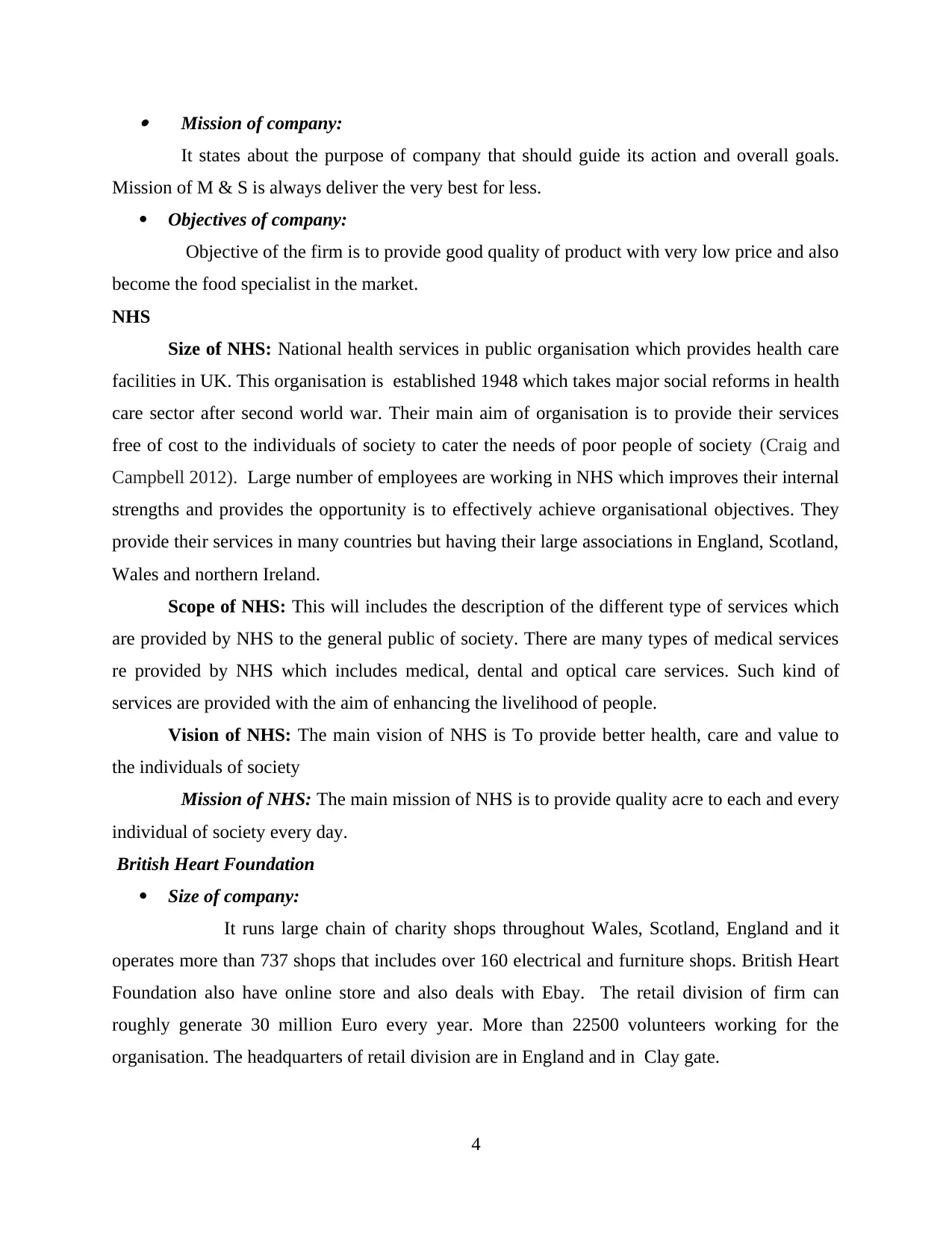
Mission of company:
It states about the purpose of company that should guide its action and overall goals.
Mission of M & S is always deliver the very best for less.
Objectives of company:
Objective of the firm is to provide good quality of product with very low price and also
become the food specialist in the market.
NHS
Size of NHS: National health services in public organisation which provides health care
facilities in UK. This organisation is established 1948 which takes major social reforms in health
care sector after second world war. Their main aim of organisation is to provide their services
free of cost to the individuals of society to cater the needs of poor people of society (Craig and
Campbell 2012). Large number of employees are working in NHS which improves their internal
strengths and provides the opportunity is to effectively achieve organisational objectives. They
provide their services in many countries but having their large associations in England, Scotland,
Wales and northern Ireland.
Scope of NHS: This will includes the description of the different type of services which
are provided by NHS to the general public of society. There are many types of medical services
re provided by NHS which includes medical, dental and optical care services. Such kind of
services are provided with the aim of enhancing the livelihood of people.
Vision of NHS: The main vision of NHS is To provide better health, care and value to
the individuals of society
Mission of NHS: The main mission of NHS is to provide quality acre to each and every
individual of society every day.
British Heart Foundation
Size of company:
It runs large chain of charity shops throughout Wales, Scotland, England and it
operates more than 737 shops that includes over 160 electrical and furniture shops. British Heart
Foundation also have online store and also deals with Ebay. The retail division of firm can
roughly generate 30 million Euro every year. More than 22500 volunteers working for the
organisation. The headquarters of retail division are in England and in Clay gate.
4
It states about the purpose of company that should guide its action and overall goals.
Mission of M & S is always deliver the very best for less.
Objectives of company:
Objective of the firm is to provide good quality of product with very low price and also
become the food specialist in the market.
NHS
Size of NHS: National health services in public organisation which provides health care
facilities in UK. This organisation is established 1948 which takes major social reforms in health
care sector after second world war. Their main aim of organisation is to provide their services
free of cost to the individuals of society to cater the needs of poor people of society (Craig and
Campbell 2012). Large number of employees are working in NHS which improves their internal
strengths and provides the opportunity is to effectively achieve organisational objectives. They
provide their services in many countries but having their large associations in England, Scotland,
Wales and northern Ireland.
Scope of NHS: This will includes the description of the different type of services which
are provided by NHS to the general public of society. There are many types of medical services
re provided by NHS which includes medical, dental and optical care services. Such kind of
services are provided with the aim of enhancing the livelihood of people.
Vision of NHS: The main vision of NHS is To provide better health, care and value to
the individuals of society
Mission of NHS: The main mission of NHS is to provide quality acre to each and every
individual of society every day.
British Heart Foundation
Size of company:
It runs large chain of charity shops throughout Wales, Scotland, England and it
operates more than 737 shops that includes over 160 electrical and furniture shops. British Heart
Foundation also have online store and also deals with Ebay. The retail division of firm can
roughly generate 30 million Euro every year. More than 22500 volunteers working for the
organisation. The headquarters of retail division are in England and in Clay gate.
4
⊘ This is a preview!⊘
Do you want full access?
Subscribe today to unlock all pages.

Trusted by 1+ million students worldwide
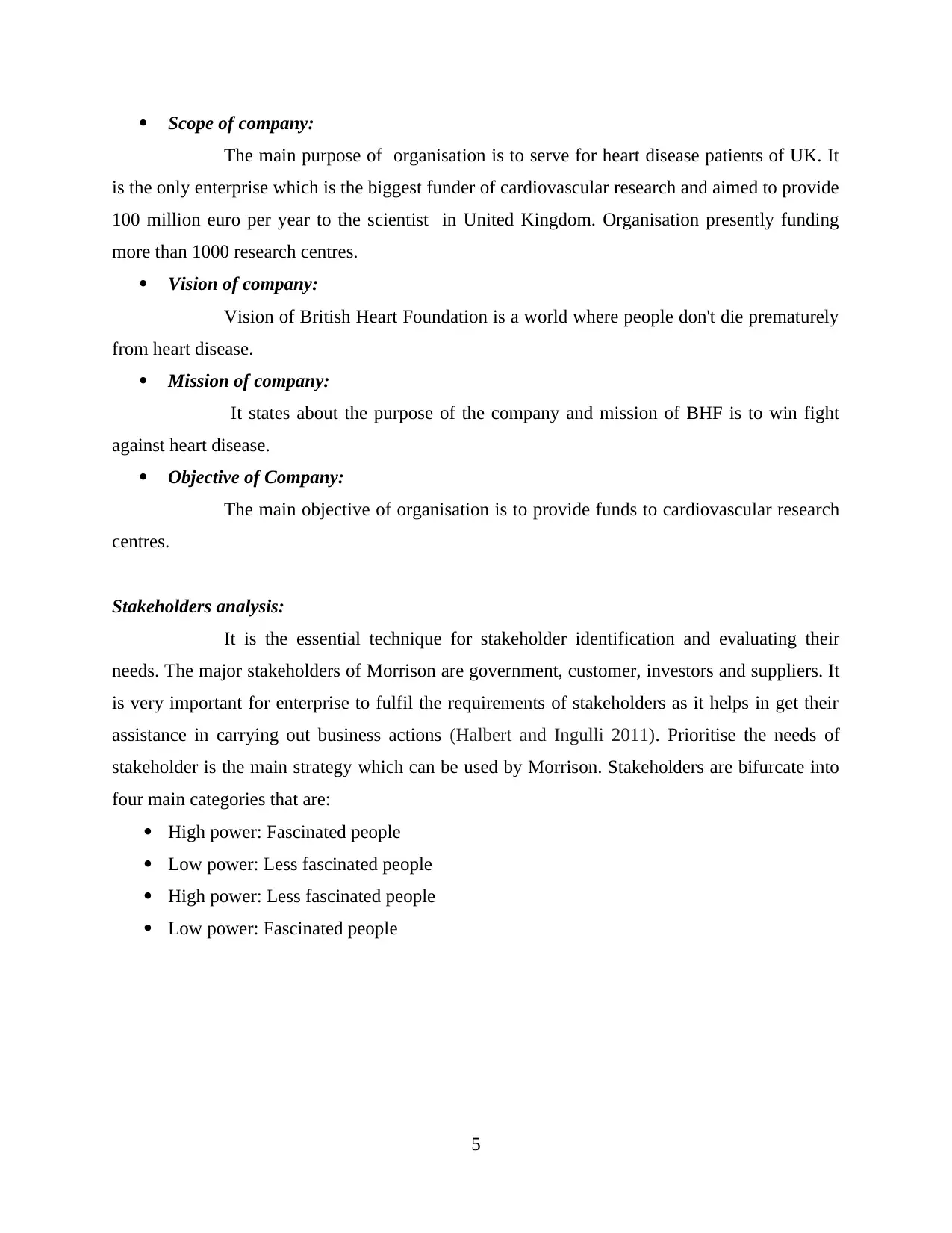
Scope of company:
The main purpose of organisation is to serve for heart disease patients of UK. It
is the only enterprise which is the biggest funder of cardiovascular research and aimed to provide
100 million euro per year to the scientist in United Kingdom. Organisation presently funding
more than 1000 research centres.
Vision of company:
Vision of British Heart Foundation is a world where people don't die prematurely
from heart disease.
Mission of company:
It states about the purpose of the company and mission of BHF is to win fight
against heart disease.
Objective of Company:
The main objective of organisation is to provide funds to cardiovascular research
centres.
Stakeholders analysis:
It is the essential technique for stakeholder identification and evaluating their
needs. The major stakeholders of Morrison are government, customer, investors and suppliers. It
is very important for enterprise to fulfil the requirements of stakeholders as it helps in get their
assistance in carrying out business actions (Halbert and Ingulli 2011). Prioritise the needs of
stakeholder is the main strategy which can be used by Morrison. Stakeholders are bifurcate into
four main categories that are:
High power: Fascinated people
Low power: Less fascinated people
High power: Less fascinated people
Low power: Fascinated people
5
The main purpose of organisation is to serve for heart disease patients of UK. It
is the only enterprise which is the biggest funder of cardiovascular research and aimed to provide
100 million euro per year to the scientist in United Kingdom. Organisation presently funding
more than 1000 research centres.
Vision of company:
Vision of British Heart Foundation is a world where people don't die prematurely
from heart disease.
Mission of company:
It states about the purpose of the company and mission of BHF is to win fight
against heart disease.
Objective of Company:
The main objective of organisation is to provide funds to cardiovascular research
centres.
Stakeholders analysis:
It is the essential technique for stakeholder identification and evaluating their
needs. The major stakeholders of Morrison are government, customer, investors and suppliers. It
is very important for enterprise to fulfil the requirements of stakeholders as it helps in get their
assistance in carrying out business actions (Halbert and Ingulli 2011). Prioritise the needs of
stakeholder is the main strategy which can be used by Morrison. Stakeholders are bifurcate into
four main categories that are:
High power: Fascinated people
Low power: Less fascinated people
High power: Less fascinated people
Low power: Fascinated people
5
Paraphrase This Document
Need a fresh take? Get an instant paraphrase of this document with our AI Paraphraser
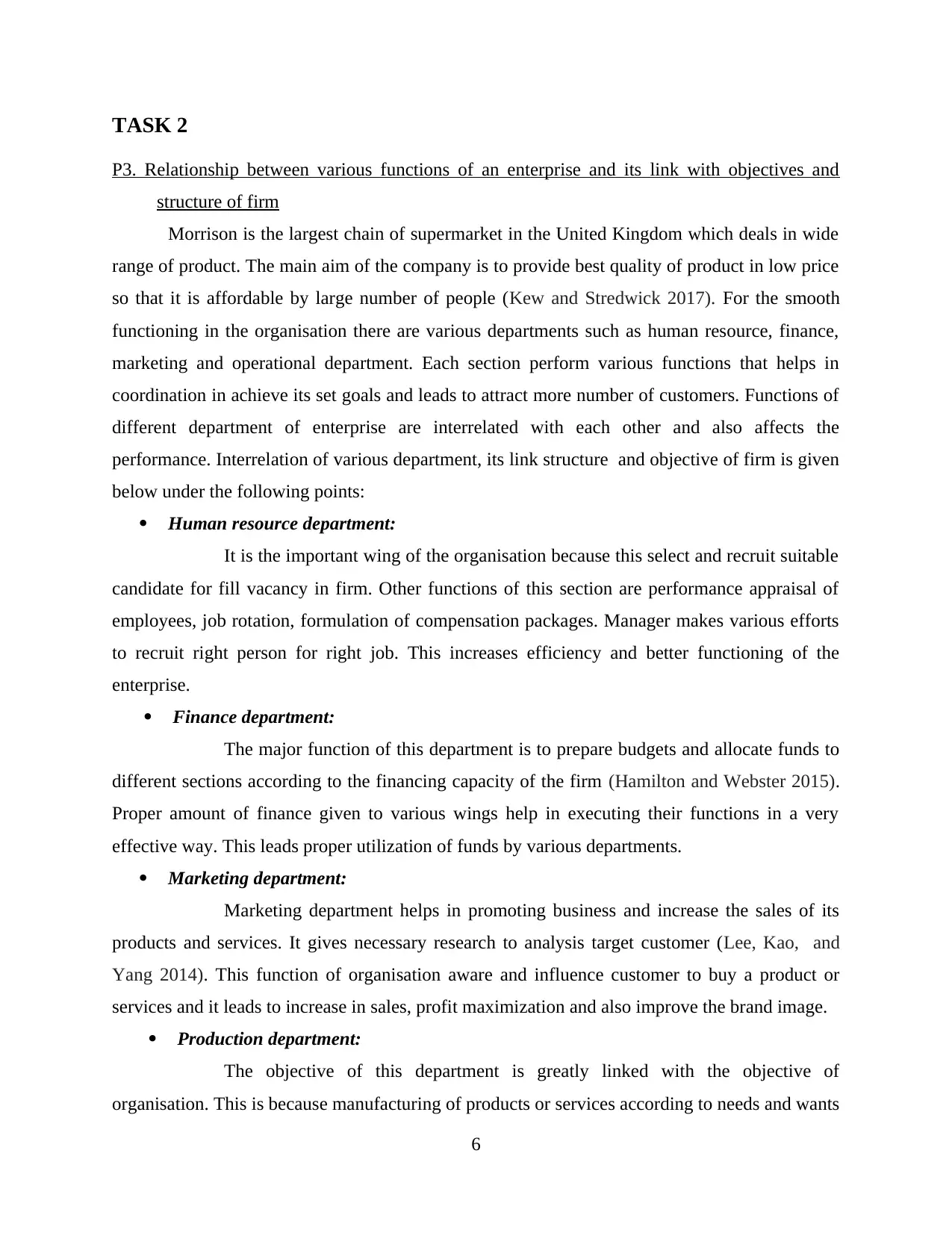
TASK 2
P3. Relationship between various functions of an enterprise and its link with objectives and
structure of firm
Morrison is the largest chain of supermarket in the United Kingdom which deals in wide
range of product. The main aim of the company is to provide best quality of product in low price
so that it is affordable by large number of people (Kew and Stredwick 2017). For the smooth
functioning in the organisation there are various departments such as human resource, finance,
marketing and operational department. Each section perform various functions that helps in
coordination in achieve its set goals and leads to attract more number of customers. Functions of
different department of enterprise are interrelated with each other and also affects the
performance. Interrelation of various department, its link structure and objective of firm is given
below under the following points:
Human resource department:
It is the important wing of the organisation because this select and recruit suitable
candidate for fill vacancy in firm. Other functions of this section are performance appraisal of
employees, job rotation, formulation of compensation packages. Manager makes various efforts
to recruit right person for right job. This increases efficiency and better functioning of the
enterprise.
Finance department:
The major function of this department is to prepare budgets and allocate funds to
different sections according to the financing capacity of the firm (Hamilton and Webster 2015).
Proper amount of finance given to various wings help in executing their functions in a very
effective way. This leads proper utilization of funds by various departments.
Marketing department:
Marketing department helps in promoting business and increase the sales of its
products and services. It gives necessary research to analysis target customer (Lee, Kao, and
Yang 2014). This function of organisation aware and influence customer to buy a product or
services and it leads to increase in sales, profit maximization and also improve the brand image.
Production department:
The objective of this department is greatly linked with the objective of
organisation. This is because manufacturing of products or services according to needs and wants
6
P3. Relationship between various functions of an enterprise and its link with objectives and
structure of firm
Morrison is the largest chain of supermarket in the United Kingdom which deals in wide
range of product. The main aim of the company is to provide best quality of product in low price
so that it is affordable by large number of people (Kew and Stredwick 2017). For the smooth
functioning in the organisation there are various departments such as human resource, finance,
marketing and operational department. Each section perform various functions that helps in
coordination in achieve its set goals and leads to attract more number of customers. Functions of
different department of enterprise are interrelated with each other and also affects the
performance. Interrelation of various department, its link structure and objective of firm is given
below under the following points:
Human resource department:
It is the important wing of the organisation because this select and recruit suitable
candidate for fill vacancy in firm. Other functions of this section are performance appraisal of
employees, job rotation, formulation of compensation packages. Manager makes various efforts
to recruit right person for right job. This increases efficiency and better functioning of the
enterprise.
Finance department:
The major function of this department is to prepare budgets and allocate funds to
different sections according to the financing capacity of the firm (Hamilton and Webster 2015).
Proper amount of finance given to various wings help in executing their functions in a very
effective way. This leads proper utilization of funds by various departments.
Marketing department:
Marketing department helps in promoting business and increase the sales of its
products and services. It gives necessary research to analysis target customer (Lee, Kao, and
Yang 2014). This function of organisation aware and influence customer to buy a product or
services and it leads to increase in sales, profit maximization and also improve the brand image.
Production department:
The objective of this department is greatly linked with the objective of
organisation. This is because manufacturing of products or services according to needs and wants
6
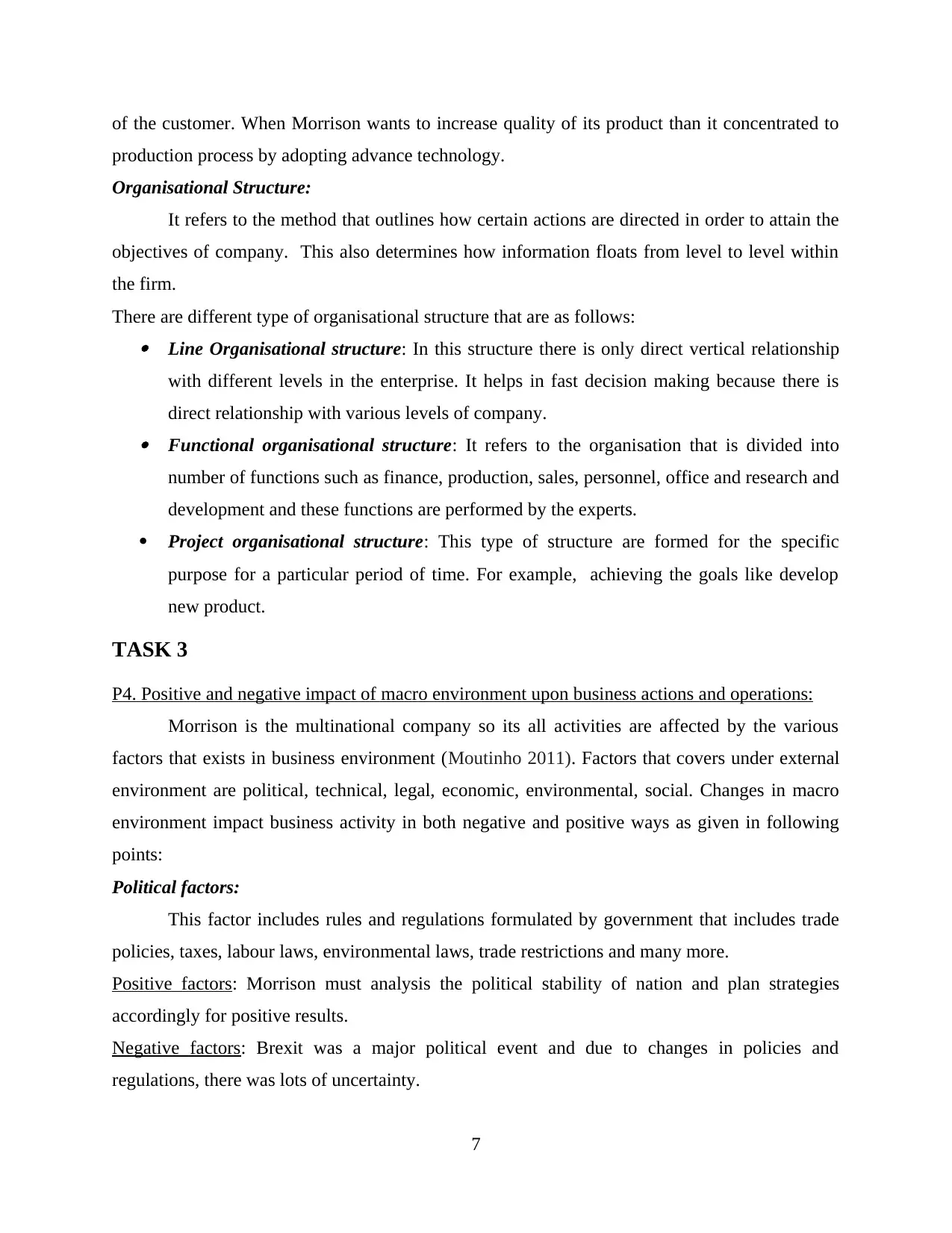
of the customer. When Morrison wants to increase quality of its product than it concentrated to
production process by adopting advance technology.
Organisational Structure:
It refers to the method that outlines how certain actions are directed in order to attain the
objectives of company. This also determines how information floats from level to level within
the firm.
There are different type of organisational structure that are as follows: Line Organisational structure: In this structure there is only direct vertical relationship
with different levels in the enterprise. It helps in fast decision making because there is
direct relationship with various levels of company. Functional organisational structure: It refers to the organisation that is divided into
number of functions such as finance, production, sales, personnel, office and research and
development and these functions are performed by the experts.
Project organisational structure: This type of structure are formed for the specific
purpose for a particular period of time. For example, achieving the goals like develop
new product.
TASK 3
P4. Positive and negative impact of macro environment upon business actions and operations:
Morrison is the multinational company so its all activities are affected by the various
factors that exists in business environment (Moutinho 2011). Factors that covers under external
environment are political, technical, legal, economic, environmental, social. Changes in macro
environment impact business activity in both negative and positive ways as given in following
points:
Political factors:
This factor includes rules and regulations formulated by government that includes trade
policies, taxes, labour laws, environmental laws, trade restrictions and many more.
Positive factors: Morrison must analysis the political stability of nation and plan strategies
accordingly for positive results.
Negative factors: Brexit was a major political event and due to changes in policies and
regulations, there was lots of uncertainty.
7
production process by adopting advance technology.
Organisational Structure:
It refers to the method that outlines how certain actions are directed in order to attain the
objectives of company. This also determines how information floats from level to level within
the firm.
There are different type of organisational structure that are as follows: Line Organisational structure: In this structure there is only direct vertical relationship
with different levels in the enterprise. It helps in fast decision making because there is
direct relationship with various levels of company. Functional organisational structure: It refers to the organisation that is divided into
number of functions such as finance, production, sales, personnel, office and research and
development and these functions are performed by the experts.
Project organisational structure: This type of structure are formed for the specific
purpose for a particular period of time. For example, achieving the goals like develop
new product.
TASK 3
P4. Positive and negative impact of macro environment upon business actions and operations:
Morrison is the multinational company so its all activities are affected by the various
factors that exists in business environment (Moutinho 2011). Factors that covers under external
environment are political, technical, legal, economic, environmental, social. Changes in macro
environment impact business activity in both negative and positive ways as given in following
points:
Political factors:
This factor includes rules and regulations formulated by government that includes trade
policies, taxes, labour laws, environmental laws, trade restrictions and many more.
Positive factors: Morrison must analysis the political stability of nation and plan strategies
accordingly for positive results.
Negative factors: Brexit was a major political event and due to changes in policies and
regulations, there was lots of uncertainty.
7
⊘ This is a preview!⊘
Do you want full access?
Subscribe today to unlock all pages.

Trusted by 1+ million students worldwide
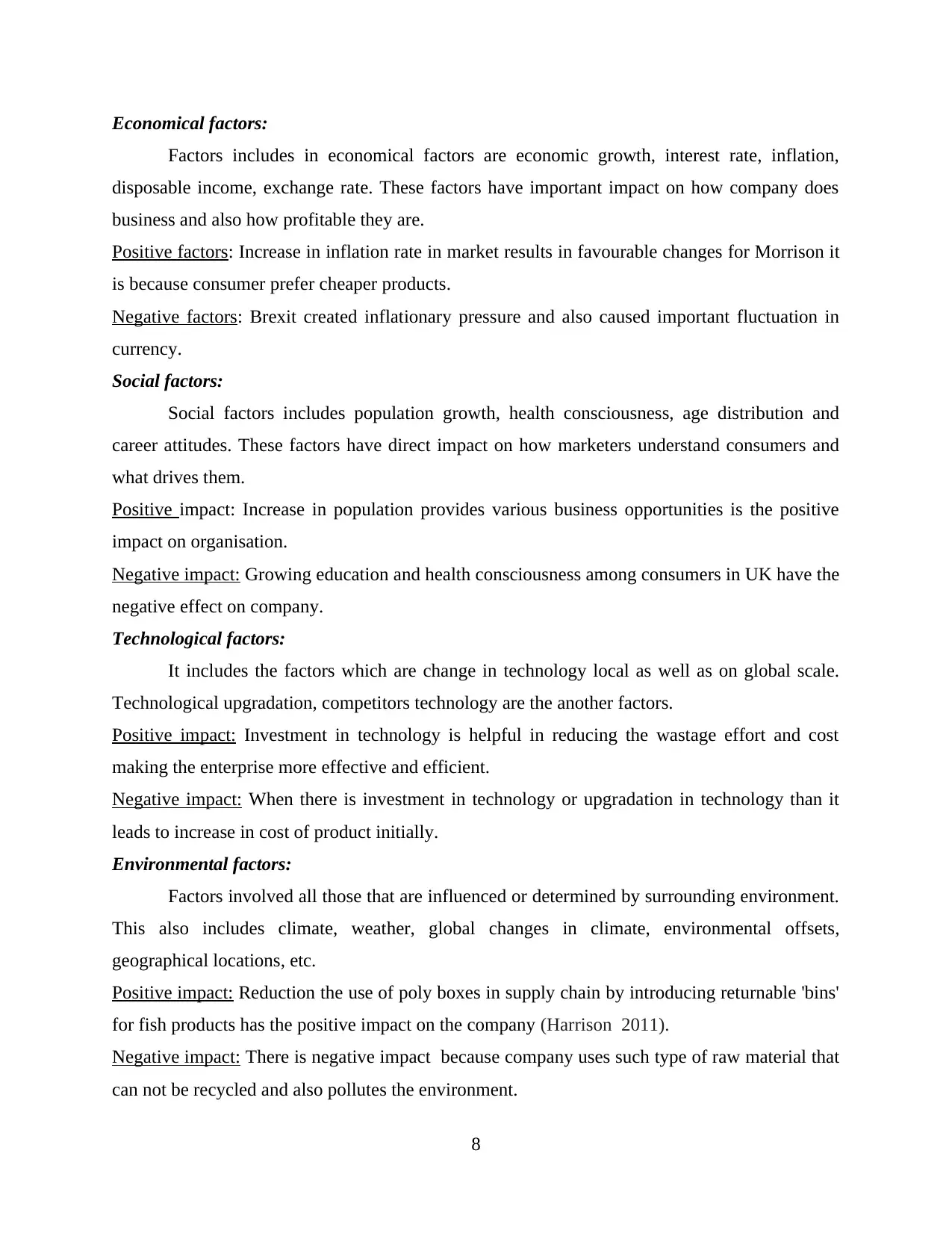
Economical factors:
Factors includes in economical factors are economic growth, interest rate, inflation,
disposable income, exchange rate. These factors have important impact on how company does
business and also how profitable they are.
Positive factors: Increase in inflation rate in market results in favourable changes for Morrison it
is because consumer prefer cheaper products.
Negative factors: Brexit created inflationary pressure and also caused important fluctuation in
currency.
Social factors:
Social factors includes population growth, health consciousness, age distribution and
career attitudes. These factors have direct impact on how marketers understand consumers and
what drives them.
Positive impact: Increase in population provides various business opportunities is the positive
impact on organisation.
Negative impact: Growing education and health consciousness among consumers in UK have the
negative effect on company.
Technological factors:
It includes the factors which are change in technology local as well as on global scale.
Technological upgradation, competitors technology are the another factors.
Positive impact: Investment in technology is helpful in reducing the wastage effort and cost
making the enterprise more effective and efficient.
Negative impact: When there is investment in technology or upgradation in technology than it
leads to increase in cost of product initially.
Environmental factors:
Factors involved all those that are influenced or determined by surrounding environment.
This also includes climate, weather, global changes in climate, environmental offsets,
geographical locations, etc.
Positive impact: Reduction the use of poly boxes in supply chain by introducing returnable 'bins'
for fish products has the positive impact on the company (Harrison 2011).
Negative impact: There is negative impact because company uses such type of raw material that
can not be recycled and also pollutes the environment.
8
Factors includes in economical factors are economic growth, interest rate, inflation,
disposable income, exchange rate. These factors have important impact on how company does
business and also how profitable they are.
Positive factors: Increase in inflation rate in market results in favourable changes for Morrison it
is because consumer prefer cheaper products.
Negative factors: Brexit created inflationary pressure and also caused important fluctuation in
currency.
Social factors:
Social factors includes population growth, health consciousness, age distribution and
career attitudes. These factors have direct impact on how marketers understand consumers and
what drives them.
Positive impact: Increase in population provides various business opportunities is the positive
impact on organisation.
Negative impact: Growing education and health consciousness among consumers in UK have the
negative effect on company.
Technological factors:
It includes the factors which are change in technology local as well as on global scale.
Technological upgradation, competitors technology are the another factors.
Positive impact: Investment in technology is helpful in reducing the wastage effort and cost
making the enterprise more effective and efficient.
Negative impact: When there is investment in technology or upgradation in technology than it
leads to increase in cost of product initially.
Environmental factors:
Factors involved all those that are influenced or determined by surrounding environment.
This also includes climate, weather, global changes in climate, environmental offsets,
geographical locations, etc.
Positive impact: Reduction the use of poly boxes in supply chain by introducing returnable 'bins'
for fish products has the positive impact on the company (Harrison 2011).
Negative impact: There is negative impact because company uses such type of raw material that
can not be recycled and also pollutes the environment.
8
Paraphrase This Document
Need a fresh take? Get an instant paraphrase of this document with our AI Paraphraser
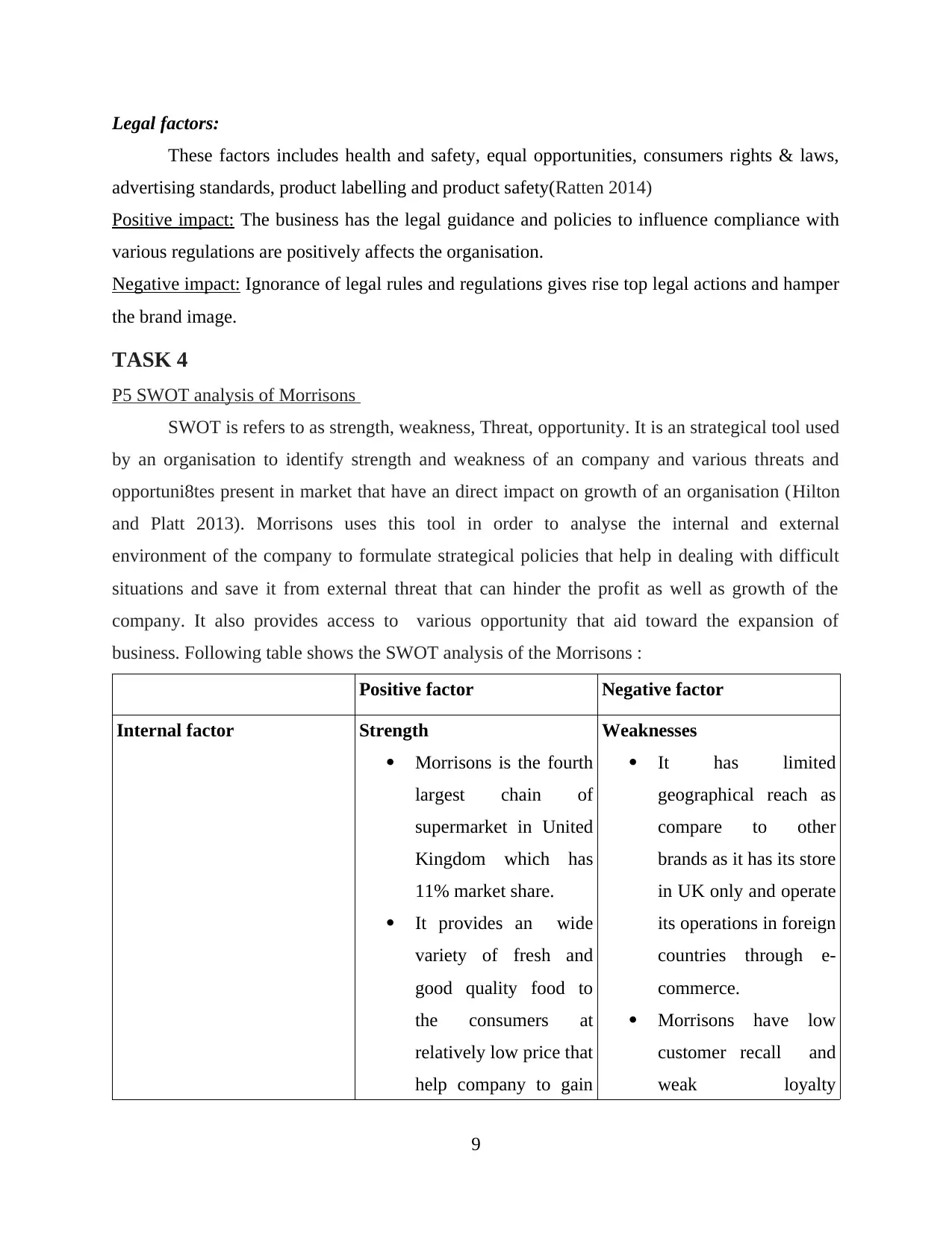
Legal factors:
These factors includes health and safety, equal opportunities, consumers rights & laws,
advertising standards, product labelling and product safety(Ratten 2014)
Positive impact: The business has the legal guidance and policies to influence compliance with
various regulations are positively affects the organisation.
Negative impact: Ignorance of legal rules and regulations gives rise top legal actions and hamper
the brand image.
TASK 4
P5 SWOT analysis of Morrisons
SWOT is refers to as strength, weakness, Threat, opportunity. It is an strategical tool used
by an organisation to identify strength and weakness of an company and various threats and
opportuni8tes present in market that have an direct impact on growth of an organisation (Hilton
and Platt 2013). Morrisons uses this tool in order to analyse the internal and external
environment of the company to formulate strategical policies that help in dealing with difficult
situations and save it from external threat that can hinder the profit as well as growth of the
company. It also provides access to various opportunity that aid toward the expansion of
business. Following table shows the SWOT analysis of the Morrisons :
Positive factor Negative factor
Internal factor Strength
Morrisons is the fourth
largest chain of
supermarket in United
Kingdom which has
11% market share.
It provides an wide
variety of fresh and
good quality food to
the consumers at
relatively low price that
help company to gain
Weaknesses
It has limited
geographical reach as
compare to other
brands as it has its store
in UK only and operate
its operations in foreign
countries through e-
commerce.
Morrisons have low
customer recall and
weak loyalty
9
These factors includes health and safety, equal opportunities, consumers rights & laws,
advertising standards, product labelling and product safety(Ratten 2014)
Positive impact: The business has the legal guidance and policies to influence compliance with
various regulations are positively affects the organisation.
Negative impact: Ignorance of legal rules and regulations gives rise top legal actions and hamper
the brand image.
TASK 4
P5 SWOT analysis of Morrisons
SWOT is refers to as strength, weakness, Threat, opportunity. It is an strategical tool used
by an organisation to identify strength and weakness of an company and various threats and
opportuni8tes present in market that have an direct impact on growth of an organisation (Hilton
and Platt 2013). Morrisons uses this tool in order to analyse the internal and external
environment of the company to formulate strategical policies that help in dealing with difficult
situations and save it from external threat that can hinder the profit as well as growth of the
company. It also provides access to various opportunity that aid toward the expansion of
business. Following table shows the SWOT analysis of the Morrisons :
Positive factor Negative factor
Internal factor Strength
Morrisons is the fourth
largest chain of
supermarket in United
Kingdom which has
11% market share.
It provides an wide
variety of fresh and
good quality food to
the consumers at
relatively low price that
help company to gain
Weaknesses
It has limited
geographical reach as
compare to other
brands as it has its store
in UK only and operate
its operations in foreign
countries through e-
commerce.
Morrisons have low
customer recall and
weak loyalty
9
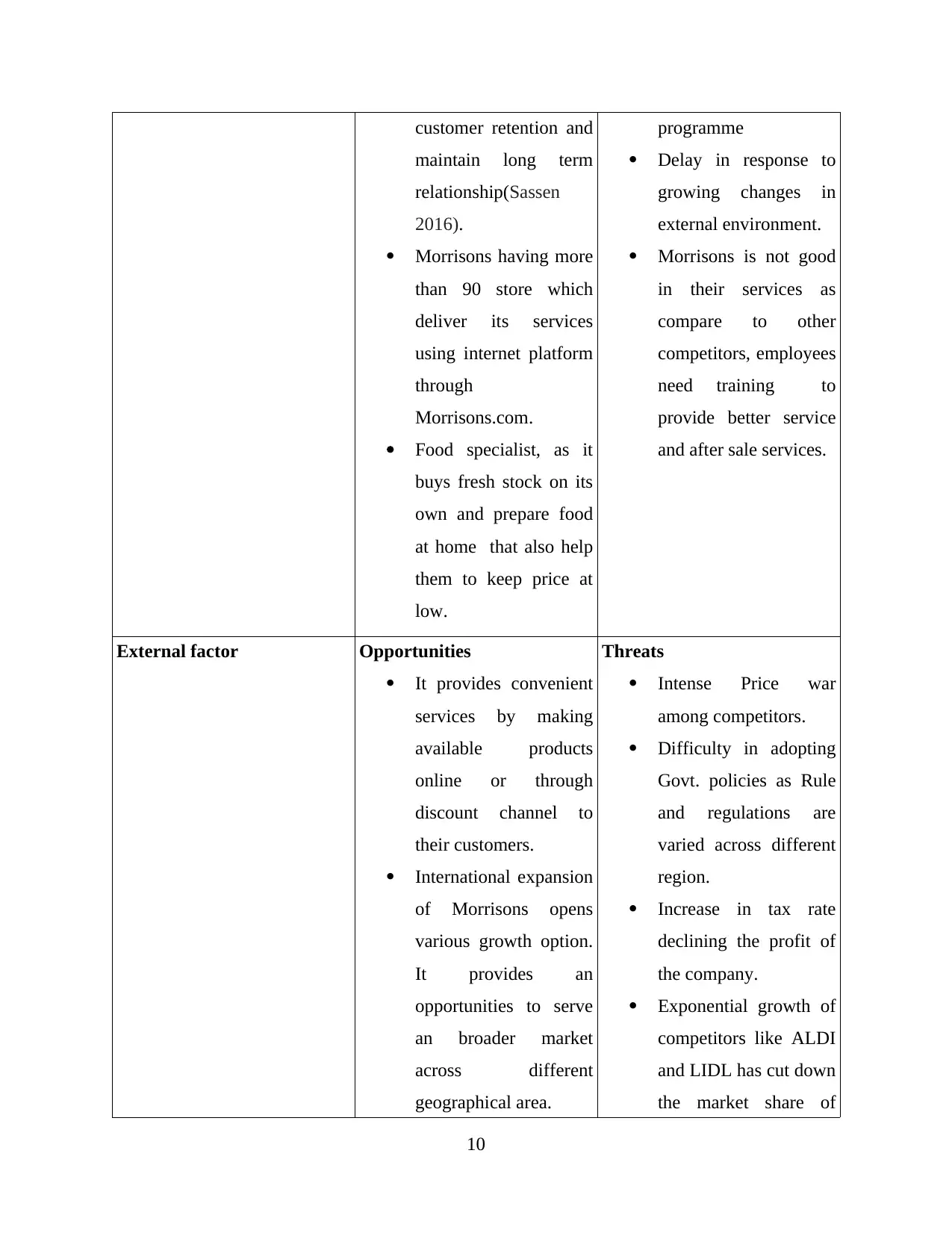
customer retention and
maintain long term
relationship(Sassen
2016).
Morrisons having more
than 90 store which
deliver its services
using internet platform
through
Morrisons.com.
Food specialist, as it
buys fresh stock on its
own and prepare food
at home that also help
them to keep price at
low.
programme
Delay in response to
growing changes in
external environment.
Morrisons is not good
in their services as
compare to other
competitors, employees
need training to
provide better service
and after sale services.
External factor Opportunities
It provides convenient
services by making
available products
online or through
discount channel to
their customers.
International expansion
of Morrisons opens
various growth option.
It provides an
opportunities to serve
an broader market
across different
geographical area.
Threats
Intense Price war
among competitors.
Difficulty in adopting
Govt. policies as Rule
and regulations are
varied across different
region.
Increase in tax rate
declining the profit of
the company.
Exponential growth of
competitors like ALDI
and LIDL has cut down
the market share of
10
maintain long term
relationship(Sassen
2016).
Morrisons having more
than 90 store which
deliver its services
using internet platform
through
Morrisons.com.
Food specialist, as it
buys fresh stock on its
own and prepare food
at home that also help
them to keep price at
low.
programme
Delay in response to
growing changes in
external environment.
Morrisons is not good
in their services as
compare to other
competitors, employees
need training to
provide better service
and after sale services.
External factor Opportunities
It provides convenient
services by making
available products
online or through
discount channel to
their customers.
International expansion
of Morrisons opens
various growth option.
It provides an
opportunities to serve
an broader market
across different
geographical area.
Threats
Intense Price war
among competitors.
Difficulty in adopting
Govt. policies as Rule
and regulations are
varied across different
region.
Increase in tax rate
declining the profit of
the company.
Exponential growth of
competitors like ALDI
and LIDL has cut down
the market share of
10
⊘ This is a preview!⊘
Do you want full access?
Subscribe today to unlock all pages.

Trusted by 1+ million students worldwide
1 out of 15
Related Documents
Your All-in-One AI-Powered Toolkit for Academic Success.
+13062052269
info@desklib.com
Available 24*7 on WhatsApp / Email
![[object Object]](/_next/static/media/star-bottom.7253800d.svg)
Unlock your academic potential
Copyright © 2020–2025 A2Z Services. All Rights Reserved. Developed and managed by ZUCOL.




